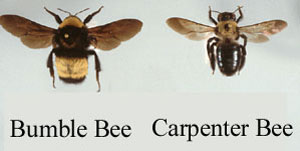Carpenter bees: Another home-wrecker
Mysterious holes in exterior wood surfaces around the home may be the work of carpenter bees.
Imagine the shock and amazement of a homeowner finding multiple, perfectly round, half-inch holes in their home’s exterior. The holes appear to be carefully drilled in the fascia board, the horizontal strip of wood where the roof ends. The holes might also be on the overhang or eaves and on the undersides of porch rails or decks. Other locations might be in wooden columns, posts or wooden trim. Cypress, redwood or cedar siding anda shingles are occasionally targets, but pine is a perpetual favorite. Often, the wood with the holes is unfinished or just stained and retains its rough texture. Painted or treated wood is not as likely to sustain holes but still can be damaged.

Photo: MSU Diagnostic Services. |
The maker of these perfect holes is just the busy carpenter bee. Carpenter bees are large, black and yellow bees that are somewhat smaller than bumble bees. Bumblebees have completely fuzzy bodies, but carpenter bees have shiny black abdomens, which is the last segment on their bodies. Both bees have yellow markings on the front part of their bodies.
In spring, usually in May, the adult female carpenter bee emerges from her winter dormancy. She often spends the winter in an old nesting tunnel hole. The males have already emerged. Daddy has no stinger but can be very protective of his territory and may use the old “dive-bomb” method of intimidation for unwitting people or insects. Mommy has a stinger but only resorts to stinging if handled or threatened.
After they mate, Mommy spends several weeks feeding on flower nectar and scouting nursery locations. Mommy carpenter bee is looking to construct a lovely place for her future-children to be born. Soft, dead wood is a perfect place to make a tunnel. She selects a place for her brood hole that feels like real, dead wood. The tunnel goes into the wood for about one-half inch or more and then turns horizontally to follow the grain of the wood. Most completed tunnels are around six inches in length but could be longer. Coarse sawdust can be found on the flat surface below the hole if this is new damage. Carpenter bees are not eating the wood; they are just chewing it out and dumping it. The female also builds a large ball of pollen and puts it in the hole to feed the kiddies.
Control for carpenter bees may be difficult. Sometimes, the damage can be stopped by changing the texture of the wood. Painting the wood or using a sealer that makes the wood feel smooth may be enough, but not always. Protective pesticide sprays do not last long enough to keep them at bay, and it is difficult to spray all vulnerable wood.
One thing that may be successful is directly treating the new holes with an appropriate pesticide like carbaryl (Sevin) dust or cyfluthrin (Multi-Insect Killer). Then plug the treated hole with a lump of aluminum foil. Caulk or fill the holes within two to three days. Adults will use the holes in the winter so they are in the area. The insecticide treatment works best because it will kill the adult bees and any immature bees that might emerge later.



 Print
Print Email
Email


